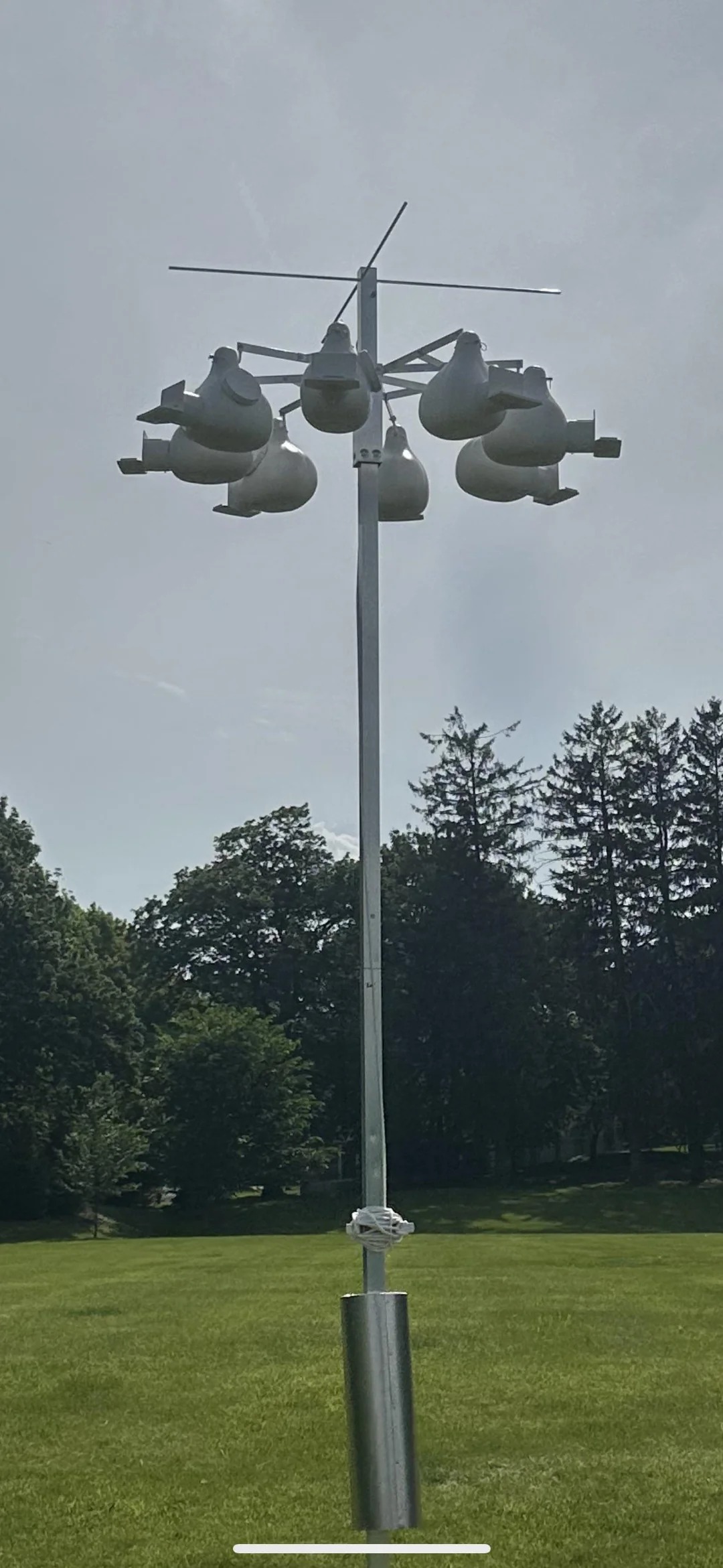If you’ve taken a walk through your local park recently and spotted a tall metal pole topped with several odd-looking white pods, you might have assumed they were security cameras or maybe some kind of weather monitoring equipment. Standing over 12 feet tall and placed prominently in open areas, these structures definitely look unusual and can spark curiosity.

But the truth behind them is actually far more fascinating and heartwarming than anything involving surveillance or high-tech gadgets. These white, bulbous objects are not cameras or sensors—they’re purple martin gourd houses, and they’re designed to provide safe, comfortable nesting spots for one of North America’s most beloved migratory birds: the purple martin. These birds are the largest swallows in North America and are admired for their sleek, dark-blue feathers that shimmer like black from afar. Even more impressive is their aerial agility—they’re famous for swooping, darting, and gliding through the sky as they catch flying insects with ease. Watching them in flight is like watching an airshow orchestrated by nature. What makes purple martins especially unique is their strong reliance on human-made structures for nesting.
In much of the eastern United States, natural nesting spaces like hollow trees have become increasingly scarce, which has led these birds to depend on specially designed housing provided by people. This special relationship has lasted for generations, with bird lovers—often referred to as “landlords”—dedicating time and effort to setting up and maintaining homes for these birds each year. The design of the gourd houses you see today traces back to early Native American and settler traditions, when people would hollow out real gourds and hang them from tall poles to attract purple martins. The modern versions are made from durable plastic and still mimic that original gourd shape for a reason.
These houses offer the perfect nesting conditions, with enough space for nests, proper ventilation, and drainage systems to keep baby birds healthy regardless of weather. The elevated height helps protect against ground predators, and the clustered arrangement mimics a colony, which is ideal because purple martins are highly social and prefer nesting near others of their kind. These gourd homes are often arranged in a circular or grouped pattern around the pole, giving multiple pairs of birds a place to nest while fostering their natural colony behavior. You might wonder why parks would install these birdhouses in the first place. The answer is simple—open park spaces are ideal for purple martins. These birds like areas with few trees and wide, clear flight paths so they can easily see approaching predators and fly freely. Public parks, with their broad, open fields, are perfect for this. Beyond providing nesting opportunities, these structures also serve broader environmental and educational purposes.
Purple martins eat a large number of flying insects, making them natural pest controllers. Their presence can help reduce populations of mosquitoes and other bothersome bugs. Additionally, these installations offer a wonderful opportunity for park visitors to learn about bird conservation, observe wildlife up close, and appreciate the role that small actions can play in helping ecosystems thrive. Some cities and bird conservation groups go a step further by actively monitoring the gourd houses. They track how many birds return each season, how many chicks hatch, and how successful the colonies are. This helps them adjust maintenance routines or designs to better support the birds. In your local park, if you look closely at one of these tall poles, you’ll likely see several individual gourd-shaped units, each serving as a separate nesting space. There’s usually a pulley system or telescoping mechanism that allows caretakers to lower the houses safely for cleaning or monitoring. And at the bottom of the pole, you might spot a shiny, smooth metal sleeve—that’s a predator guard designed to keep animals like raccoons or snakes from climbing up to disturb the birds. So the next time you see one of these strange-looking poles in a park, you can smile knowing it’s not about surveillance or technology—it’s about giving purple martins a safe, welcoming place to call home.




